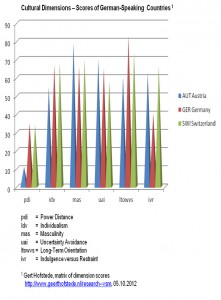Author: Doris Kündig
Due to globalization intercultural communication is becoming increasingly important. Moreover, mobility and the rapid development of communication technologies lead to ever more contacts between people of different cultures.
To facilitate the understanding of cultural differences, among other things in the business world, Geert Hofstede has developed the cultural dimensions theory. This analysis tool enables to gain a group-related cultural overview. The following dimensions are aspects of a culture, which in relation to others can be measured and compared:
- Power Distance
- Uncertainty Avoidance
- Individualism versus Collectivism
- Masculinity versus Femininity
- Long-Term Orientation versus Short-Term Orientation
- Indulgence versus Restraint
The graphic below shows that even if two persons speak one language they most probably think and act differently because of their specific cultural background.
If there are already differences within the German-speaking regions, shouldn’t the model consider the cultural differences within a nation as well, e.g. the linguistic regions of Switzerland? I think, at least we should.

indeed, cultural aspects should also be considered nationally – as this is very costly, minimum the following communication medium should be adjusted at least in the respective languages for the main brochures, websites, direct mailings
I agree with that assessment! Still, when it comes to Switzerland there are 3 (or even 4) national languages segmented to very small (out of global perspective) markets. Location Winterthur decided to communicate in english and german only in order to be as cost efficient as possible: http://www.location-winterthur.ch
Absolutely true! This post shows the limitations of Gerd Hofstede’s model. I experience the same in my professional life within a company that has more than 100 branches all over Switzerland. There are huge differences between and even within the linguistic regions. These differences matter and have to be taken into account not only when communicating internally but also externally. So, brochures, a website or an employee magazine only in German? Not at Implenia. But see for yourself: http://www.implenia.com/en/media/publications/html
There’s no doubt about it! Cultural background strongly influences communication. It shapes the way we understand the world. I am fascinated about discovering differences from how language is used and what is understood. Across cultures, certain words are used in different ways. As per instance “ahora” even in countries that share Spanish language, the meaning of this word varies from “right now” to “soon” to “quite recently”. Stunning! See: http://lema.rae.es/drae/?val=ahora
Great post – great comments. From misunderstandings because of different languages, to misunderstandings because of different meanings – this topics requires really any further discussion.
And we’re only at the level of the language factor yet.
Just also think of geographical reasons (north vs. south italy; mountain vs. sea level,…).
However in terms of business and the money to be spent in the most efficent way, of course it comes always down to the lowest common denominator.